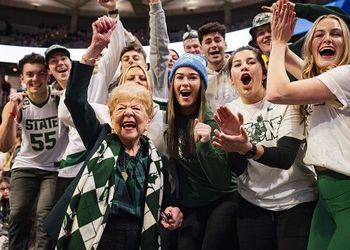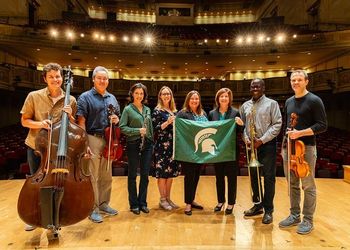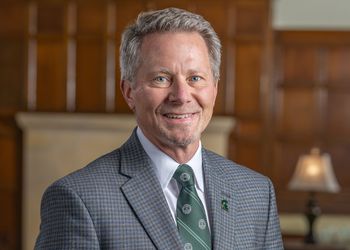Feature: A Lifetime of Memories in "Sport Nut" Heaven

A retired Detroit sportswriter recounts the greatest highlights of his four-decade Hall of Fame career.
From the cramped press box in the rafters of Jenison Field House and the Stabley Hilton press box at Spartan Stadium to British Opens on the Old Course at St. Andrews and Muirfield, to 38 Masters Tournaments in Augusta to the “Miracle on Ice” in the 1980 Olympics at Lake Placid to the champion 1957 Lions and 1968 Tigers, I’ve been more than fortunate since I graduated from Michigan State with a journalism degree in 1956.
There was a lot of good fortune. I didn’t get sent to Korea during my two years in the Army, I finished school thanks to the GI Bill® and during my senior year I worked half-time in the Lansing bureau of United Press. That led to being hired full-time upon graduation as UP’s one-man Michigan sports department.
The bureau was on the first floor of the Detroit News garage in downtown Detroit. The windows were painted black and everyone was young and eager and addicted to the wire service’s “Deadline every minute” motto. You learned to write fast, write short and be able to dictate off the top of your head.
Gael Greene, Phil Thomas and Bob Irvin were the stars of the bureau. Greene went on to New York, became New York magazine’s food critic and wrote a few erotic novels; Thomas, whose aunt Helen covered the White House for the Washington bureau, was a consummate newsman with some sharp humor; and Irvin was the No. 1 auto beat writer in the country and eventually worked for the New York Times.
I was the sports guy and covered the Tigers, Lions, Red Wings, and the Pistons when they came to Detroit from Fort Wayne, the “other school,” the University of Michigan, the small colleges and the high schools. It was a great experience and a job sports nuts would kill for.
I was a sports nut as a kid and it helped that my father was traveling secretary of the Tigers from 1940-51. I spent a lot of time at Briggs Stadium and Hank Greenberg was my idol. He was the classiest ballplayer I ever knew and that included the years I covered the Tigers as an adult at United Press (which became United Press International at the end of the 50s, when it took on Hearst’s International News Service).
I knew nothing about golf when I started at UPI but that changed fast. Detroit was a golf hotbed with the pro tour’s Motor City Open (the purse was $25,000), the 1958 U.S. Women’s Open at Forest Lake with Mickey Wright the wire-to-wire winner, and the first Buick Open in 1958 at Warwick Hills. That purse was a mind-boggling $52,000, the biggest purse on tour, and when Billy Casper beat Arnold Palmer and Ted Kroll for the $9,000 first prize, Casper wondered if they had enough money to pay the purse.
Warwick Hills had been carved from a cornfield and was featureless compared to today’s tight tree-lined fairways. It was 7,200 yards, the longest course on tour and that was in the days of persimmon woods and golf balls that got out of round, before exotic shafts, huge metal heads, square grooves and balls engineered like space ships.
I got lucky again after the 1959 high school basketball tournament ended at Jenison Field House. The tournament was the toughest part of the job because every district, then every regional, called the result in to the wire services. The Associated Press bureau had double our staff and I was the one man show at UPI. I took every call, and naturally they all called at about the same time. I wanted out and got hired at the Free Press.
In little more than a year Marshall Dann, another Spartan alum and beat writer for the Red Wings, golf and small college football, went to the Chicago-based Western Golf Association as executive director. I wound up with the Wings, golf, some of the small college beat, skiing and then MSU football in the Denny Stolz era.
For starters there were Gordie Howe and the Red Wings and the 1961 United States Open at Oakland Hills. It was perfect.
My three favorite athletes were Greenberg, Howe and Jack Nicklaus. Greenberg was a great home run hitter, 58 in 1938, two shy of Babe Ruth’s record. He enlisted n the Army after Pearl Harbor and returned to the Tigers during the 1945 pennant drive. His grand slam home run on the last day of the season gave the Tigers the pennant and put them into the World Series against the Cubs. The Tigers won in seven games and my dad got a full share, $6,400, and it paid off our house.
Howe was the most un-starlike superstar I’ve ever known. A Canadian record was out in the 1960s, “Gordie Howe, the greatest of them all.” Absolutely true. Typical of Howe was his patience in signing autographs. Never a scribble. Always a very neat and legible Gordon Howe.
Nicklaus always seemed more formal than Howe. Like Howe, Nicklaus is a great family man, but without Gordie’s humor and playfulness. And great wives, Gordie’s Colleen, and Jack’s Barbara.
Nicklaus came to Oakland Hills for the 1961 U.S. Open still an amateur. He was runner-up to Palmer the previous year at Cherry Hills, Arnie’s only Open victory. Nicklaus played the final round there with Ben Hogan who was a contender until the watery 17th hole. Afterward Hogan said he’d played with the one who should’ve won.
Nicklaus tied for fourth at Oakland Hills but the next year, on Palmer’s home turf at Oakmont Country Club, Nicklaus beat Palmer in a playoff, 71 to 74. The two things I remember most are Ohio State football coach Woody Hayes, in the gallery following Buckeye Nicklaus, wearing his “uniform” white short sleeve shirt and dark cap with the scarlet “O,” and Palmer, asked afterward to assess Nicklaus, complimented his game but added, “He should play faster.” Jack gave new meaning to the word “deliberate.”
The 1963 Open was at The Country Club in Brookline, MA, two weeks after the Buick Open. Nicklaus, Palmer and Gary Player were golf’s Big Three at the time and they skipped the Buick. Julius Boros won the Buick and then beat Palmer and Jacky Cupit in a playoff at the Open and Buick PR and tournament director Jerry Rideout couldn’t have been more pleased. Nicklaus had missed the cut, Player tied Michigander Walter Burkemo for eighth and it was the second of three playoff defeats for Palmer in the national championship.
Burkemo roomed with another Detroit pro, Bob Gajda, who became a trivia contest question: Who played all four rounds of the U.S. Open without a round in the 70s? Gajda was the first round leader with a 69 but then shot 80-84-80 and finished 46th.
“All night,” Burkemo said, laughing, the next day after Gajda’s leading 69, “all I heard was ‘Click-click, click-click.” And he clicked a Zippo cigarette lighter open and closed. Gajda’s record still stands, incidentally.
I thought the Free Press had the best staff and one of the best sports sections in the country in the 1960s and the highlight was the Tigers’ seven game World Series victory over St. Louis in 1968. Denny McLain won 31 games and, unlike today, wasn’t yanked after six innings for a middle reliever, a set-up reliever and a closer. And the games often were over in less than two hours.
While the Free Press was a great place to work, the Old Gray Lady down the street on Lafayette, the Detroit News, spent more money covering everything. Bill Brennan covered the Red Wings for the News and when the NHL expanded from six to 12 teams, taking in Vancouver, Oakland, Los Angeles, St. Louis, Minnesota and Philadelphia, I couldn’t get west of the Mississippi because of the one-hour time difference for Minnesota and St. Louis and three-hour difference to the West Coast. Games ended after our last deadline but the News was an afternoon paper and Brennan went.
Often I covered games off the TV or radio and I clipped the agate special to the Free Press line on the stories and pasted it on the bottom of the TV screen.
I became the hockey writer at the News and then golf as well and when Nicklaus won the 1972 Masters and nearly holed his 1-iron tee shot on the 17th at Pebble Beach to win the U.S. Open, I was sent to Scotland to cover the British Open at Muirfield. The hook was that the PGA Championship was going to be played in August at Oakland Hills and Nicklaus was aiming for an unprecedented Grand Slam. Bobby Jones’ Slam was two Amateurs, the U.S. and British, and two Opens, U.S. and British. Nicklaus would have the only all-pro slam.
But Lee Trevino, who’d beaten Nicklaus in a playoff for the 1971 U.S. Open and was Nicklaus’s most formidable rival throughout their careers, denied him. Nicklaus had bunker problems in the final round and just when it seemed British favorite Tony Jacklin would win, Trevino chipped in on the 17th and Jacklin collapsed with a three-putt. Trevino won and Nicklaus slipped past Jacklin into second place.
The British Open is the oldest in golf but the Royal & Ancient’s idea of a press facility didn’t match American tournament setups. The tent was pitched on grass. Slanted ground. And no board floor. When we wrote in the evening after play was over, the damp came up through the ground. Nothing like the lush facilities at majors now with TV coverage so expansive that many writers never leave the tent. I always liked to get out and get the flavor of the action, the crowd, hear the cheers and groans.
Before the Open started, and thanks to the long twilight hours in Scotland, four of us drove up to St. Andrews and played the Old Course. No problem then and I don’t think it was even 10 pounds. Now it’s $250 for the Old Course and you have to reserve a spot far, far in advance. Actually, the way prices have shot up that’s a bargain for a once in a lifetime experience. The K Club in Ireland, where the Ryder Cup was played last year, is $472.50 and it is nowhere near the Old Course on the list of the world’s greatest and just the look and feel of walking around in St. Andrews is incomparable. Of probably the thousands of courses I’ve been to, my top three are St. Andrews, Pebble Beach and the Augusta National. Settings made in golf heaven.
Editor Bob Bao said to write 2,000 words. I’ve exceeded it and haven’t hit Secretariat’s Triple Crown with a Belmont victory margin almost the length of the track; Stanley Cups at the Montreal Forum and Maple Leaf Gardens, the two best-all-time hockey rinks; the Dolphins’ perfect season and Garo Yepremian’s ill-fated “pass” that gave the Washington Redskins a glimmer of Super Bowl hope; and two Indy 500s including the 1973 disaster. I saw a bumper sticker when I first got to town that read: “Murphy’s Law. Anything that can go wrong, will.” And it did—rain delays, terrible, fiery crashes, and deaths. Jackson oil man Pat Patrick’s Gordon Johncock had the winning car but Swede Savage, like a son to him, in his other car, was burned so badly in a fourth turn crash that he died and one of the Patrick team’s pit crew members was struck by a fire truck going to the Savage crash and was killed. Those are scenes I’ll always remember.
Fortunately all the good times outweighed the bad and one of the most enjoyable is interviewing MSU journalism sophomores for the Golf Writers Association of America scholarship, funded by the PGA, to help a student through the junior and senior year. The scholarship is $4,000 annually now.
It started in 1988 and every recipient has been outstanding, beginning with Stephanie Reitz of Lake Orion who works at the Hartford Courant, through Matt Rudy of Saginaw, senior writer on instruction at Golf Digest magazine, Nedra Pickler (see p. 11. Spring 2007) of Flint who covers the White House for the Associated Press, and Melissa Sanchez of South Lyon who has had more top offers than I can count.
Journalism has changed in many ways since I left MSU. There aren’t as many newspapers. Typewriters and filing at Western Union are for the Smithsonian; now it’s instant communication with computers. But one thing hasn’t changed, the drive, the energy and the talent of the students and I’m proud to have been in a field that, for its participants, is much more than a business.
Jack Berry, ’56, was born in Detroit, graduated from Catholic Central High School in 1949, attended Marquette University, 1949-51, served in the U.S. Army, 1952-54, enrolled at Michigan State in 1954 and graduated in 1956 from MSU’s School of Journalism. At MSU he was summer editor of the State News in 1955 and sports editor in 1955-56 while also serving as a sports stringer for United Press International.
After graduation he was hired by UPI and became the one-man sports staff covering the Tigers, Lions, Red Wings and Pistons plus University of Michigan football and golf. Berry moved to the Detroit Free Press sports staff in 1959 and his primary beats were the Red Wings and golf. He went to the Detroit News in 1971, was columnist for a year and then was assigned to golf and winter sports including the 1980 Winter Olympic Games at Lake Placid and the gold medal hockey team and speed skater Eric Heiden’s run of five gold medals.
Berry retired from the News at the end of 1993 and presently freelances and is a partner in Grand Rapids-based All About Golf, a media relations firm. Berry is a past president of the Professional Hockey Writers Association and the Golf Writers Association of America. He was Secretary of the GWAA from 1990-98. In 2003, he became only the second writer elected to the Michigan Golf Hall of Fame, and in 2007, he received the PGA’s Lifetime Achievement Award in Journalism.
Berry has four daughters and three of them, Anne Daugherty, Karen Gebhardt and Jill Berry are MSU graduates. Susan Berry is a Northwestern graduate. His oldest grandson, Jacob Gebhardt of Cedar Springs, will be an MSU freshman this fall.



